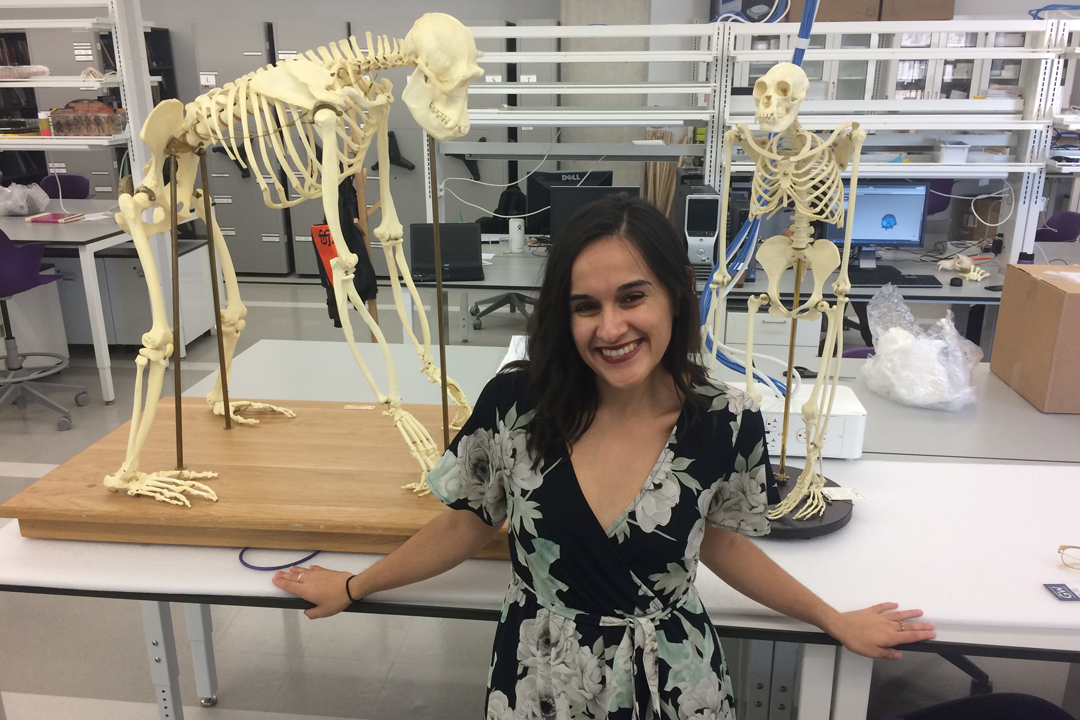For decades, human paleobiologists have largely agreed on a simple anatomy lesson: Our primate relatives have large torsos—wider pelvises, broader thoraxes, expanded ribcages—to accommodate a digestive system that processes a diet of leaves, fruit and insects. Humans, with a more nutritional meal plan, require smaller frames. Evolution seems to confirm it: Somewhere between one-and-a-half and 3 million years ago, our hominin ancestors shifted their diets away from plants and bugs toward scavenging and hunting animal prey—and their torsos began to shrink.
But Eve Boyle, a PhD student in Columbian College’s Center for the Advanced Study of Human Paleobiology, wasn’t convinced. For two years, she has travelled to museums across the United States and Europe, reconstructing the bones of primates from the last century—using digital calipers and putty—and comparing the size of their torsos with information on their diets. With the help of senior biological anthropology major Rowan Sherwood, she devised a method for measuring the cubic volume of primate guts based on their skeletons. The pair used software to create a 3D “bubble” within the bone scans that replicates realistic gut volumes.
Measuring nearly 450 skeletons and studying the 3D scans of primate bones stored at archives around the world, Boyle has all but dispelled the widely accepted scientific theory connecting torso size to diet. A more likely hypothesis, she says, points to body shape changing to meet a primate’s range of motion.
“She has shown that factors other than diet drive torso shape in higher primates,” said her research mentor Professor of Human Origins Bernard Wood. “So we can no longer base inferences about diet in our ancestors and close relatives on torso shape.”
No Bones About It
From the heel bone to the ankle bone to the hip bone, Boyle has connected human and primate anatomy for more than four years at GW. She has been a lead author on papers in prestigious journals such as PaleoAnthropology and the Journal of Human Evolution, including well-cited studies with Wood. A National Science Foundation Graduate Research Fellow, Boyle has contributed to work that is reshaping the way scientists looks at hominin skeletons—literally from head to toe.
Boyle had always been skeptical of the diet-torso connection. And as she prepared her dissertation research, she realized that no one had ever tested if there was a relationship between bone-size and diet in modern primates. “Everyone was making an assumption based on just a few reconstructed skeletons from 20 years ago,” she said. “But there were no scientific citations because no one had actually done the measurements.”
Boyle, who won the university’s 2019 Philip J. Amsterdam Teaching Award for her classroom impact as a teaching assistant, will be defending her doctoral dissertation this summer and is preparing her torso-diet findings for publication. While she’s uncertain whether she’ll pursue other research opportunities, she hopes to continue teaching and mentoring young scientists.
“Teaching is a passion for me,” Boyle said. “When you expose young people to all the possibilities in the world, they can picture themselves doing incredible things.”


